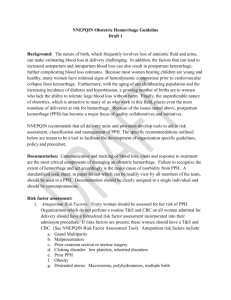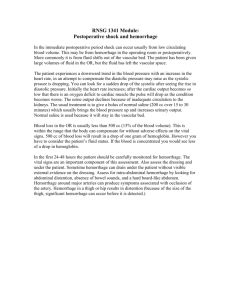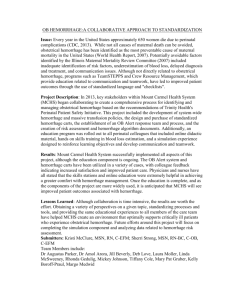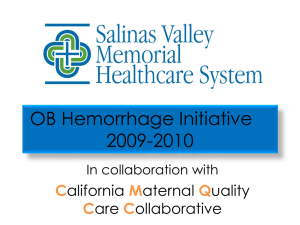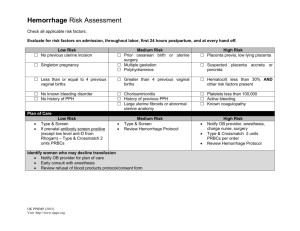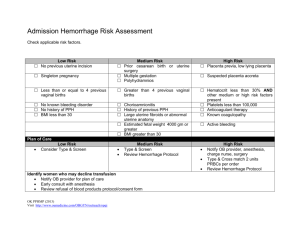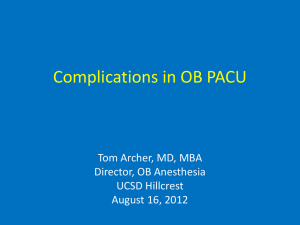Draft PPH Guideline
advertisement
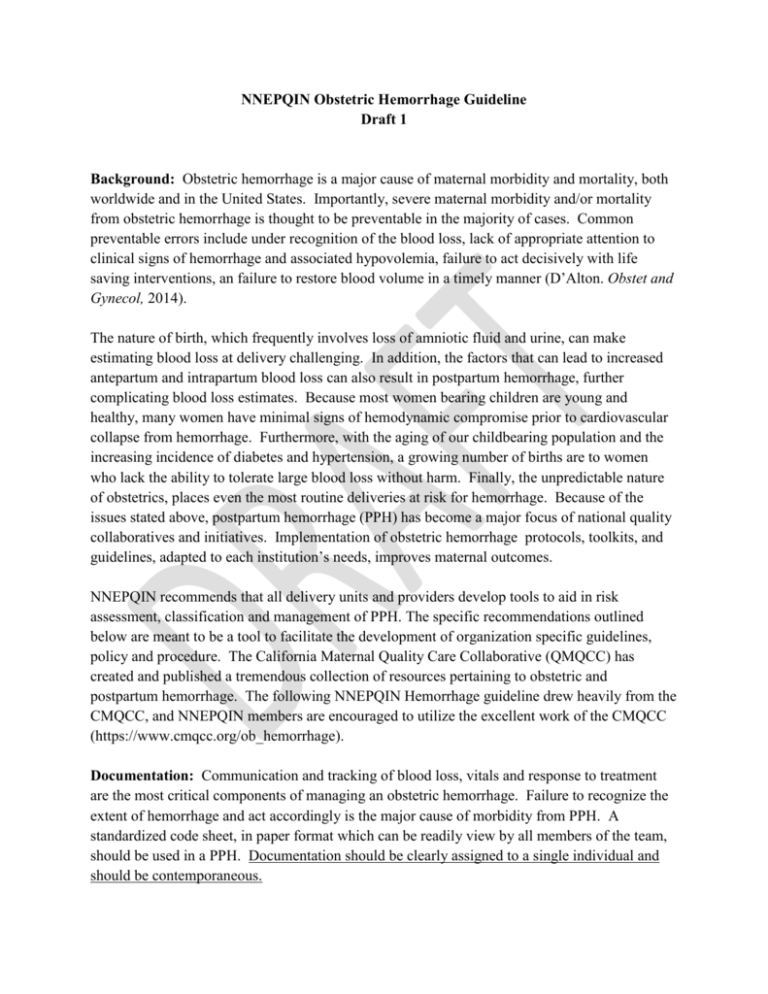
NNEPQIN Obstetric Hemorrhage Guideline Draft 1 Background: Obstetric hemorrhage is a major cause of maternal morbidity and mortality, both worldwide and in the United States. Importantly, severe maternal morbidity and/or mortality from obstetric hemorrhage is thought to be preventable in the majority of cases. Common preventable errors include under recognition of the blood loss, lack of appropriate attention to clinical signs of hemorrhage and associated hypovolemia, failure to act decisively with life saving interventions, an failure to restore blood volume in a timely manner (D’Alton. Obstet and Gynecol, 2014). The nature of birth, which frequently involves loss of amniotic fluid and urine, can make estimating blood loss at delivery challenging. In addition, the factors that can lead to increased antepartum and intrapartum blood loss can also result in postpartum hemorrhage, further complicating blood loss estimates. Because most women bearing children are young and healthy, many women have minimal signs of hemodynamic compromise prior to cardiovascular collapse from hemorrhage. Furthermore, with the aging of our childbearing population and the increasing incidence of diabetes and hypertension, a growing number of births are to women who lack the ability to tolerate large blood loss without harm. Finally, the unpredictable nature of obstetrics, places even the most routine deliveries at risk for hemorrhage. Because of the issues stated above, postpartum hemorrhage (PPH) has become a major focus of national quality collaboratives and initiatives. Implementation of obstetric hemorrhage protocols, toolkits, and guidelines, adapted to each institution’s needs, improves maternal outcomes. NNEPQIN recommends that all delivery units and providers develop tools to aid in risk assessment, classification and management of PPH. The specific recommendations outlined below are meant to be a tool to facilitate the development of organization specific guidelines, policy and procedure. The California Maternal Quality Care Collaborative (QMQCC) has created and published a tremendous collection of resources pertaining to obstetric and postpartum hemorrhage. The following NNEPQIN Hemorrhage guideline drew heavily from the CMQCC, and NNEPQIN members are encouraged to utilize the excellent work of the CMQCC (https://www.cmqcc.org/ob_hemorrhage). Documentation: Communication and tracking of blood loss, vitals and response to treatment are the most critical components of managing an obstetric hemorrhage. Failure to recognize the extent of hemorrhage and act accordingly is the major cause of morbidity from PPH. A standardized code sheet, in paper format which can be readily view by all members of the team, should be used in a PPH. Documentation should be clearly assigned to a single individual and should be contemporaneous. Risk factor assessment: 1. Antepartum Risk Factors: Every woman should be assessed for her risk of PPH on admission to Labor and Delivery. Organizations which do not perform a routine T&S and CBC on all women admitted for delivery should have a formalized risk factor assessment incorporated into their admission procedure. If risks factors are present, these women should have a T&S and CBC. (See NNEPQIN Risk Factor Assessment Tool). Antepartum risk factors include: a. Grand Multiparity b. Malpresentation c. Morbid Obesity d. Prior cesarean section or uterine surgery e. Bleeding disorders f. Prior PPH g. Obesity h. Distended uterus: Macrosomia, polyhydramnios, multiple birth i. Abnormal uterus: fibroids, bicornuate, other anomaly j. Placental abnormalities: previa*, suspected accreta*, low lying, abruption k. Platelet count < 100 or low Fibrinogen < 200 2. Intrapartum Risk Factor Assessment: Ongoing assessment of risk for PPH should occur throughout labor, minimally at the beginning of the second stage, regardless of other unit protocols. For organizations who do not perform routine CBC and T&S a formalized risk assessment strategy within documentation or ordering protocols should occur. Intrapartum risk factors include a. Bleeding: increased or suspected abruption b. Operative Delivery c. Chorioamnionitis d. Placenta: retained, succenturiate, low lying e. Magnesium Sulfate or tocolytic agents f. Labor abnormalities: Precipitous, Prolongation of any phase, including induction 3. High Risk Patients: Patients at high risk for PPH should have 2 units of PRBC readily available. Patients who are at significant risk for requiring a massive transfusion should be delivered in facilities with ready capabilities to meet these needs. The factors listed below place a patient at high risk. a. Blood group antibody and a risk factor, otherwise T&S on admission b. Abnormal platelet count or low Fibrinogen and the presence of another risk factor c. Placenta previa or accreta Third Stage Management: Active management of the third stage is recommended for all women, regardless of delivery location. Active management is typically defined as: use of a uterotonic agent (oxytocin is preferred) within 3 minutes of delivery, controlled cord traction, and fundal massage immediately after delivery of the placenta (Westhoff. Chochrane Database, 2013). Estimation of Blood Loss (EBL) 1. Pre-Delivery: EBL should be obtained prior to every delivery and noted. a. Cesarean Delivery: i. Scheduled: Estimated blood loss (EBL) should be noted prior to rupture of membranes and should include blood in suction canisters and on lap pads. i. Unscheduled: EBL should be estimated prior to the uterine incision, and should include all blood lost up to the time of uterine incision. Anticipated Vaginal Delivery: EBL should be estimated just prior to delivery b. Vaginal Delivery: Blood loss should be estimated just prior to delivery. Clean chucks and drapes should be considered either just prior or after delivery if these become filled with pre-delivery blood loss or amniotic fluid. 2. Methods of Estimation of blood loss a. Quantitative: Quantitative estimation using scales is the preferred method. Dry weights of commonly used items should be posted in labor rooms, possibly posted inside a delivery kit. b. Qualitative: Visual estimation of product saturation is another method, but may be more prone to error. Ongoing education using posters and other visual tools is particularly important, and has been shown to improve blood loss estimates (Zuckerwise. Obstetrics&Gynecology, 2014). 3. Posters or visual tools should be available at each delivery, regardless of the EBL method. (See NNEPQIN Guide for Quantitative Estimation and FAHC Qualitative Estimation Guide) 4. Ongoing EBL estimation and documentation should be performed until normal lochia is achieved. a. If heavier than normal bleeding is encountered, chucks and sponges should be saved for potential weighing or qualitative assessment. b. If bleeding increases after the recovery period, EBL estimations should resume. OB Rapid Response Team: Some units may wish to consider an OB Rapid response team which could include 1. Lab to draw blood and notify Blood Bank 2. Blood bank runner 3. IV team 4. Administrator on Call 5. Anesthesia Provider 6. OR Staff 7. OB MD 8. Members of ICU or ED Massive Transfusion Protocol (MTP): 1. All institutions providing delivery services should have a general MTP with a separate section for obstetric considerations*. 2. The MTP protocol should be activated with any Class 3 hemorrhage or after transfusion of 4 or more units of RBC with possibility of further blood loss, including ongoing oozing 3. *Obstetric Considerations for the MTP a. After initial transfusion of 4units, it is strongly recommended that FFP and RBC be transfused in a 1:1 ratio. This is essential once a massive transfusion is being administered. b. A Fibrinogen of < 200 is abnormal in obstetrics and cyropercipitate should be transfused. c. Continued transfusion should be based on ongoing blood loss and hemodynamic values. Resulted labs are useful when deciding if additional products need to be given earlier such as cryopercipitate, calcium or platelets. d. Initial labs are the most important to obtain, as they give a starting point. They should be drawn as soon as there is concern for hemorrhage. Additional labs should be at least every other round of transfusion packets. Most institutions consider a transfusion packet to be 4-6 units of PRBC and FFP. e. Platelets should be transfused after 10-12 units of PRBC, and/or if platelets are <100K with ongoing bleeding. 4. Transfusion Documentation: Units should document what is actually picked up from the blood bank and what is transfused. In a massive transfusion, where meticulous electronic documentation may not be feasible, it is not uncommon to have discrepancies between what the blood bank states was released vs what clinicians state was transfused. The easiest method to document in a massive transfusion may be on paper. Appropriate paper flow sheets should be available. OR Case Grading System: Units may wish to consider having a standard case grading system for non-scheduled cases that all surgical and anesthesia providers agree upon. This will facilitate activating additional resources. 1. An example a case grading system is listed below, with the anticipated time for the patient to be brought to the OR with a full assembled team and ready to care for the patient. a. A < 30 minutes b. B 30-120 minutes c. C < 6 hours 2. Class 3 PPH is considered a Grade A case. Drills: All units should engage in regular drills and debriefing of PPH. Drills should emphasize assigned tasks. Classes of Postpartum Hemorrhage & Management(See NNEPQIN Map of PPH Guideline) Class 1: If EBL is > 250 cc above a standard delivery or there is concern for hemorrhage at any point, including after the recovery period, and NORMAL vital signs (Class I hemorrhage < 15% of blood volume) 1. Initiate Quantitative EBL (See NNEPQIN Guide for Quantitative EBL) 2. Transfer patient to hospital if home delivery 3. Begin Obstetric Hemorrhage code sheet. (See CMC Obstetric Hemorrhage Code Sheet) 4. Call additional resources: a. More nurses-medication administration, start IV or second IV b. If midwife doing birth-call OB c. Runners: to get PPH cart, send labs, get blood etc 5. Q15min vitals (BP and Pulse) and document on flow sheet (consider an automatic cuff, especially if resources are scarce) 6. Immediate IV, CBC and T&S if not already obtained 7. Determine and address cause of bleeding a. Give additional uterotonics 8. Initiation of an institution specific OB hemorrhage protocol and tool kit with cart a. Uterotonic Card (See NNEPQIN Uterotonics Guide) b. Causes of OB hemorrhage card (See NNEPQIN Guide Causes of PPH) c. PPH Escalation flow chart (See NNEPQIN Guideline Map for PPH) Class 2: Ongoing bleeding despite additional uterotonics with EBL < 1500 cc and NORMAL Vitals. (Class II Hemorrhage EBL 15-30% of blood volume) 1. Call additional resources a. OR Staff b. Anesthesia c. ICU d. Lab, including blood bank e. Interventional Radiology if available 2. Strongly consider moving to the OR especially if there are visualization or pain control issues 3. Anesthesia to bedside 4. Consider notifying ED and ICU of potential admission 5. DIC panel: PT, PTT, Fibrinogen, Platelets 6. Draw a Glass Red Top and note time to clot (See NNEPQIN Red Top Clot Tool) 7. Transfuse 2 U PRBC (and use blood warmer) and strongly consider thawing FFP a. If there are any concerns for transfusion reaction or intolerance, contact pathologist immediately or intensivist. 8. Once hemorrhage has resolved, ensure patient is wearing SCDs until mobile. Once patient has been hemodynamically stable for 6-12hours, consider a short course of chemoprophylaxis with either SQ Heparin or Lovenox. Class 3: ANY one of the following: Ongoing bleeding with EBL > 1500 cc, > 2 UPRBC transfused, Possible DIC OR 15% change in vital signs (Class III hemorrhage: EBL 30%-40% of blood volume) 1. Move to OR 2. Call experienced GYN surgeon or consider a general surgeon or trauma surgeon (especially if ICU staff not present in house) 3. Activate massive transfusion protocol a. Transfuse PRBC and FFP 1:1 4. Call additional resources (may be part of a rapid response team) a. Lab to manage blood draws and deliver labs and blood products b. Additional nursing staff for vitals and ongoing I&O estimation c. Anesthesia or ICU physicians d. Pathologist for the blood bank, if they do not routinely come in with a MTP 5. Keep the patient warm: blood and fluid warmers, bear huggers 6. If there are no platelets available in the hospital a. Determine if they can be obtained from another institution and transported with the aid of the state police b. If feasible, transfer to a tertiary medical center i. If transferring: Include hemorrhage flow sheet, give regular updates to the attending who will be caring for the patient (may be different from the person taking phone calls), make sure nursing sign out occurs, continue contact with tertiary center as labs return after patient has left. 7. If there is continued surgical site bleeding and inability to correct the coagulopathy, consider the following: a. Pelvic packing and leaving the abdomen open. i. Typically a bowel bag or other plastic barrier (such as a sterile x-ray cassette cover or IV bag cut open at the bottom) is used protect the pelvic structures from adhesion to the packing materials. ii. Serial lap pads may be tied together, or multiple roles of curlex may be tied end to end and the pelvis is packed tightly. The end of the bowel bag may be fed through a vaginal cuff and put under tension to ensure pressure. iii. A wound vacuum specific for open fascia can be used. iv. The packing is typically removed in 24-48 hours, after the patient is stabilized and any coagulopathy is corrected. 8. After resolution of hemorrhage, with hemodynamic stability for 6-12hours, recommend short term chemothromboprophylaxis (either SQ Heparin or prophylactic Lovenox) in addition to SCDs (which are placed as soon as feasible). Class 4: Sudden CV Collapse concerning for AFE or Hemorrhage with significant hypotension, thready pulse with tachycardia, lethargy or coma, cold extremities. (Class IV hemorrhage EBL>40%) 1. Initiate all steps in Stage 3, including MTP, ICU notification 2. Proceed to OR immediately for uterine artery ligation and hysterectomy 3. If unable to control bleeding, consider packing and leaving incision open Outcome Indicators: QA/QI should be considered for every PPH Proposed indicators for Stage 1 or 2 hemorrhage 1. Time recognized 2. Quality of contemporaneous documentation 3. Ongoing vital and EBL estimation every 15’ during the hemorrhage 4. Time to first blood products 5. Time to OR 6. Appropriate responses by stage 7. Quantitative EBL used as an ongoing vs qualitative EBL 8. Where risk factors present and noted in the chart and appropriately acted on 9. Hypothermia 10. >15% vital sign changes 11. Did vital sign changes trigger the next stage? 12. Labs ordered on time? 13. If delay in labs, clot tube obtained 14. Transfusion per protocol? 15. Where labs slowing down transfusion 16. Was transfusion initiated in a timely manner and MTP appropriately called? 17. Where medications given in appropriate doses? 18. Was active management of 3rd stage performed? 19. Was thromboprophylaxis used- SCDs and/or heparins? Potential HEN CMS and regional measures 1. Hypothermia 2. Hypotension 3. Tachycardia 4. Shock 5. Renal compromise 6. Cardiac compromise 7. Use of Cryopercipitate 8. Use of FFP if > 4 units PRBC transfused 9. ICU LOS > 24 hours Outcome Measures 1. 2. 3. 4. 5. Unplanned hysterectomy Interventional radiology utilization ICU admission Prolonged hospitalization with >4units PRBCs given Venous thromboembolism (rare, but hemorrhage is a significant and under-discussed risk factor) Supporting Documents: Bibliography NNEPQIN Risk Factor Assessment Tool B-Lynch Picture CMC PPH Code Sheet NNEPQIN Uterotonics Guide NNEPQIN PPH Guideline Map NNEPQIN Quantitative EBL Estimation Tool FAHC Qualitative EBL Estimation Tool NNEPQIN Guide to Blood Product Transfusion NNEPQIN Red Top Clot Tool References: 1. 2. 3. 4. 5. 6. 7. 8. 9. 10. 11. 12. 13. 14. ACOG Practice bulletin 76, Postpartum Hemmorhage 2006. ACOG (2014). Active Management of the Third Stage of Labor. Cochrane Systematic Review. ACOG (2013). Patient Safety Checklist: Postpartum Hemorrhage (Number 10). AAP & ACOG (2012). Guidelines for Perinatal Care (7th edition). American Academy of Family Physicians (2008). Advanced Life Support in Obstetrics (ALSO). California Maternal Quality Care Collaborative (CMQCC): Hemorrhage Taskforce (2009). http://www.CMQCC.org. D’Alton et al. The National Partnership for Maternal Safety. Obstet and Gynecol 2014; 123(5): 973-77. Lowdermilk, Perry, Cashion, Alden, Mosby (2012). Maternity & Women’s Health Care (10th edition).Simpson, K., and Creehan, P. (2008). Perinatal Nursing (3rd edition) Westhoff et al. Prophylactic oxytocin for the third stage of labour to prevent postpartum haemorrhage. Cochran Database Syst Rev; Oct 30 2013. Zuckerwise et al. Use of a novel visual aid to improve estimation of obstetric blood loss. Obstet Gynecol 2014; 123(5):982-6.
